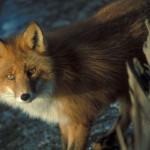By Monte Sonnenberg
Simcoe Reformer
August 27, 2013
 SIMCOE – Animal rights activists have taken credit for the mass release of fox and mink at a fur farm east of Simcoe this week.
SIMCOE – Animal rights activists have taken credit for the mass release of fox and mink at a fur farm east of Simcoe this week.
Nearly 500 animals in all were released sometime early Monday morning at the Bollert Fur Farm on Highway 3 west of Renton.
The culprits did not leave clues to their identity. However, the Animal Liberation Front has taken responsibility for the incident, which the Norfolk OPP are treating as a break-and-enter.
“In the early morning of August 26, ALF raided (the Bollert farm) in Simcoe,” a posting at the Direct Action website says. “We approached the fur farm and laid down in the tall grass so we could watch the guard’s building for any sign of movement. Once we were satisfied it was empty, we cut the bands that attach the chain link fence to the poles and then tore a large area of fence down at the back of the farm and opened the front gate. We estimate we released about 750 mink and 50 fox.”
The Bollert farm is located on Highway 3 on the west side of Renton. The owner is Robert Bollert. Bollert referred all inquiries to the Canadian Fur Council.
CFC spokesperson Nancy Daigneault said about 500 animals in all were released. Most have been rounded up. The Ministry of Natural Resources is assisting with the effort.
Eighty of the released animals were foxes. Of these, 25 remained on the loose as of Tuesday afternoon. Another 140 mink are missing.
Crimes such as this are not common in Canada. Daigneault said there was one animal release last year. The release in Renton is the first in Canada reported to the fur council this year.
“It’s so disappointing what’s happened to him (Bollert),” Daigneault said. “It’s a nuisance and an act of extremism that strikes fear into the heart of any farmer. And it’s a criminal act. It creates a lot of stress for the farmer because it’s an attack on his livelihood. It’s terrorism. They are terrorizing the farmer. That’s what they are doing.”
Daigneault added those responsible are not doing the affected animals any favours. These are domesticated animals that rely on humans for survival. They are not, she said, suited for life in the wild.
Animals raised on fur farms gravitate to highways when they escape, possibly because the sound of traffic reminds them of a food cart as it approaches their cage. Daigneault expects many of the missing animals will die on the road. In their news release Tuesday, the Norfolk OPP said the missing animals pose no danger to the public.
In their posting on the Internet, those claiming responsibility said they will not stop until fur farming in Canada is brought to its knees.
“The fox almost seemed to understand what was happening because – once they realized they were free – they wasted no time leaving their cages and escaping through the holes we made in the fence.
“After the fur farmer’s house lights flicked on, we quickly started pulling off breeding cards and tossing them around the empty cages and then made our retreat through the corn fields with a noisy group of mink experiencing their first taste of freedom. We won’t stop until this and all fur farms are empty.”
The statement ends with the initials “ALF.”

